長方形連続可変型金属NDフィルター
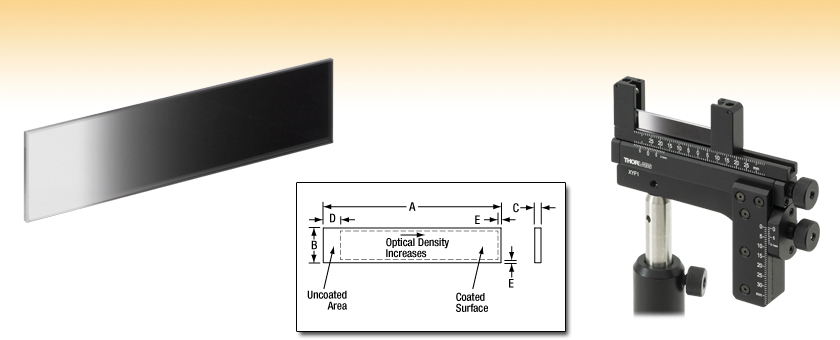
- Ideal for Use in Building a Variable Attenuator
- Optical Densities: 0.04 - 2.0 and 0.04 - 4.0
- Two Sizes Available
NDL-25C-2
25 mm x 100 mm ND Filter
OD: 0.04 to 2.0
Application Idea
NDL-10C-4 Variable ND Filter Held
in an XYF1 Translating Filter Mount
(XYF1 Maximum Filter Width: 76.2 mm)

Please Wait
| Variable ND Selection Guide | ||||||
|---|---|---|---|---|---|---|
| Image |  |  |  |  |  |  |
| ND Filter Type | Round Step | Round Continuous | Cage Compatible | Rectangular Step | Rectangular Continuous | Variable Absorptive ND Filter |
特長
- 連続可変減衰
- 0.04~2.0または0.04~4.0の光学濃度範囲
- 2つのサイズから選択可能
当社の長方形連続可変金属(反射型)NDフィルタは、単一の光学素子で連続的に光学濃度(OD)を変えることが可能です。このフィルタは通常、可変減衰器として使用されます。サイズは10 mm×50 mmまたは25 mm×100 mm (H×W)で、光学濃度は0.04~2.0または0.04~4.0のいずれかをお選びいただけます。詳細については、「仕様」タブをご参照ください。UV溶融石英(UVFS)基板製で金属インコネルコーティングが施されています。このフィルタに使用されているUV溶融石英は、優れた透過率を示し、レーザ誘起蛍光が実質見られないため(193 nmで測定)、UV域から近赤外域までの用途にお使いいただけます。短波長側の限界である240 nmは、基板による光の吸収によって決まります。長波長側の限界は、インコネルコーティングの不透明度の影響で1200 nm近辺となっていますが、多少のバラツキがあります(基板のUV溶融石英は2.1 µmまで高い透過率を有しています)。各フィルタのODは設計波長である633 nmでの仕様です。ご使用波長によって若干のバラつきが生じます。OD(下記等式参照)はコーティングの最初からリニアに増加します。
光学濃度(OD)は光学フィルタによりもたらされる減衰率、つまり入射ビームの光パワーをどれだけ減少させるかを示しています。光学濃度(OD)は透過率Tの関数として次の方程式で表されます。

Tは0から1の間の値です。光学濃度の高いNDフィルタ(吸収型)を選択した場合、入射光の吸収率は高く、透過率は低くなります。透過率を高く、吸収率を低くするためには、低い光学濃度のNDフィルタが適切と言えます。例えば、光学濃度2のフィルタでは透過率が0.01であり、フィルタは入射ビームのパワーを1%まで減衰させるという結果になります。当社のNDフィルタの透過率のデータは、パーセント(%)で表示されています。連続式可変型NDフィルタ使用時の距離に応じた透過率のプロット図は「グラフ」タブをご参照ください。
インコネルは、UV域から近赤外域まで平坦なスペクトル特性が得られる金属合金です。このインコネルのように保護膜の無い金属コーティングは、接触によって表面に傷がつく可能性がありますので、クリーニングの際は空気を吹きかけるのみで、絶対に触らないようにしてください。これらは反射型NDフィルタですが、インコネルコーティングが入射光をある程度吸収するため、使用は光の強度が余り大きくない用途に限定されます。インコネルは標準環境下の経年劣化には耐性がありますが、高温環境下においては酸化します。酸化を防ぐため、こちらのNDフィルタは100°C以下での使用を推奨いたします。最良の性能を得るには、インコネルコーティングが施されている側から光を入射してください。
NDL-10C-2およびNDL-10C-4はXY移動マウントXYF1/Mを使用して取り付けることができます。ただし、2本の取付けアームで挟むとフィルタのエッジの一部が隠れますのでご注意ください。
これらのフィルタはレーザ安全用としてご提供している製品ではありません。 当社は実験環境の安全性を高める製品として、迷光や反射光を大幅に低減する安全用および遮光用製品を多数ご用意しています。
| Common Specifications | |
|---|---|
| Substrate Material | UV Fused Silicaa |
| Length Tolerance (A & B) | +0.00 / -0.25 mm |
| Coating Tolerance (C & D) | ±0.25 mm |
| Coating | Front: Inconel (NiCrFe) Back: Uncoated |
| Spectral Range | 240 - 1200 nm |
| Surface Flatness (@633 nm) | 1λ per 25 mm |
| Surface Quality | 60-40 Scratch-Dig |
| Wedge | < 3 arcmin |
Item Specifications
| Item # | Optical Density Rangea | A | B | C | D | E |
|---|---|---|---|---|---|---|
| NDL-10C-2 | 0.04 - 2.0 | 50 mm | 10 mm | 2 mm | 5 mm | 1 mm |
| NDL-10C-4 | 0.04 - 4.0 | 50 mm | 10 mm | 2 mm | 5 mm | 1 mm |
| NDL-25C-2 | 0.04 - 2.0 | 100 mm | 25 mm | 2 mm | 10 mm | 2 mm |
| NDL-25C-4 | 0.04 - 4.0 | 100 mm | 25 mm | 2 mm | 10 mm | 2 mm |
左のプロット図は、NDフィルタの端からの距離(下の概略図のAの長さ)に応じた光学濃度と透過率を示しています。光学濃度と透過率は635 nmでの仕様です。光学濃度と透過率の生データはこちらからダウンロードいただけます。
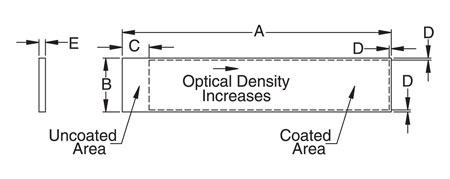
| Posted Comments: | |
Ben Urban
(posted 2025-05-07 11:35:22.57) Does the incident light not transmitted get absorbed or reflected? Eva Roche
(posted 2024-09-06 10:55:46.527) Good morning
I am Eva Roche, a researcher at the University of Zaragoza. I am interested in Continuously Variable Density Filters to work with a continuous 500mW laser (DPL) with a diameter of about 700um. We would like to know if you have any filters that are not damaged by this amount of mW.
Thank you for your attention
Best regards jpolaris
(posted 2024-09-06 07:06:35.0) Thank you for contacting Thorlabs. At this time we do not have comprehensive LIDT data for these continuously variable reflective ND filters. However, as a guideline, we found it best to keep the CW irradiance under 25 W/cm^2 for a Ø1 mm beam at 532 nm. You can calculate an LIDT adjusted to your wavelength by taking (LIDT Power)*((Your Wavelength)/(LIDT Wavelength)). In this case, LIDT Power would be 25 W/cm^2, and LIDT Wavelength would be 532 nm. I calculate your irradiance to be ~130 W/cm^2, which would be too powerful for these continuously variable reflective ND filters. Possibly somewhat counterintuitively, absorptive ND filters generally will have higher LIDT than reflective ND filters. For CW sources, we present LIDT in terms of linear power density [W/cm]. I calculate your uniform linear power density to be ~7.2 W/cm, and your Gaussian linear power density to be ~14.3 W/cm. We do have some absorptive ND filters that can withstand your source. The following link will take you to our selection of absorptive ND filters. If you require a variable absorptive ND filter, search the part number NEV0830M. https://www.thorlabs.com/newgrouppage9.cfm?objectgroup_id=5011 Madhavi Thakre
(posted 2024-04-09 17:40:17.957) Kindly provide the OD data and reflectance data also over a wavelength range of 240 - 1200 nm, other than the design wavelength (633 nm). jdelia
(posted 2024-04-11 02:21:55.0) Thank you for contacting Thorlabs. I have reached out to you directly to discuss your application and share the relevant data we have on hand. Thomas Dreischer
(posted 2023-02-21 13:52:14.78) We would need such a variable ND filter, but in the 1550 nm band (“C band”)
Could this be done?
Kind regards,
Thomas Dreischer cdolbashian
(posted 2023-04-03 01:56:29.0) Thank you for reaching out to us with this inquiry! These variable filters use nominally the same coating as the line of single OD reflective ND filters. Although we don't have data for the continuous change for the whole range of this ND filter, likely you can interpolate the data from each singular Reflective ND filter from the main filter page. Luca Bau
(posted 2022-07-06 15:04:03.54) It is specified that the OD will vary over the usable range. Do you happen to have data for wavelengths, other than the design wavelength (633 nm), such that I could estimate the variation for my setup, as I use different wavelengths? ksosnowski
(posted 2022-07-08 03:29:46.0) Hello Luca, thanks for reaching out to Thorlabs. We have OD data for the filter at various wavelengths. We were unable to send an email to the address which you provided. If you wish to have a direct discussion with us, please reach out to your local tech support team at Europe@thorlabs.de Melanie Saayman
(posted 2022-03-02 02:13:38.49) I realize these filters are specified up to 1200 nm, but do you have some performance data up to 1700 nm? cdolbashian
(posted 2022-03-08 11:49:15.0) Thank you for reaching out to us Melanie. While we do not have data for all the values of the continuously varying OD that is a feature of this filter, I have sent you extended performance data for OD values of 0.1,0.2,0.3,0.4,0.6,1,1.3,2,3,4. Hopefully this data will be helpful to your application. Martha Salazar-Romero
(posted 2021-03-04 05:24:34.67) Which is the power damage threshold for the variable neutral density filter? YLohia
(posted 2021-03-12 04:03:00.0) Thank you for contacting Thorlabs. Unfortunately, we have not yet performed intensive damage threshold tests on these filters to be able to characterize this parameter. The variable filters used in these filter wheels are similar to the NDC series UVFS variable filters located here. https://www.thorlabs.com/newgrouppage9.cfm?objectgroup_id=1393&pn=NDC-100C-2#1389. The damage thresholds recorded on this webpage will be mostly applicable for the NDL series filter wheels. felipe.hall
(posted 2018-12-28 13:50:48.883) The NDL-25C-2 has no simple way to mount it consistently to a motorized stage such as the MTS50-Z8. Using spring clips simply won't meet our application. Any plans on making something to meet this need? YLohia
(posted 2019-01-02 09:27:24.0) Hello, you may use the FP02 to mount the NDL-25C-2 to your MTS50-Z8. That being said, I have posted your request for a longer version of the XYF1 on our internal engineering forum. rbjaculbia
(posted 2018-07-01 22:53:00.11) Hi,
Which fixed mount do you recommend for these filters? Thanks! YLohia
(posted 2018-07-03 10:03:29.0) Thank you for contacting Thorlabs. We recommend the XYFM1 and many of the mounts on this page https://www.thorlabs.com/newgrouppage9.cfm?objectgroup_id=1446 dhseo
(posted 2017-08-24 08:15:04.917) I bought this filter to use my test. But it has a lot of reflection, so beam quality is lower. Can you add some extra AR coating at this filter? (I use 532 nm laser. So 532 nm AR coating is needed!!) I don't care it's price, if AR coating is possible. Please answer to my e-mail. Thnaks. tfrisch
(posted 2017-09-07 03:14:46.0) Hello, thank you for contacting Thorlabs. I will reach out to you to discuss a quote for the AR coated version. neil.troy
(posted 2014-07-30 16:12:00.063) Can you investigate creating a linear, in transmission, ND filter? The exponential transmission of these doesn't work well with our application. jlow
(posted 2014-08-07 03:04:48.0) Response from Jeremy at Thorlabs: Thank you for the suggestion. We are looking into carrying this in the future. We should be able to do a custom job for this at the moment. We will contact you directly to discuss about this. huarui.sun
(posted 2014-07-28 19:49:57.07) What's the thickness of the coating on NDL-25C-2? besembeson
(posted 2014-08-18 01:39:45.0) Response from Bweh at Thorlabs USA: This is a continuously variable neutral density filter hence the coating thickness varies across the structure to give the variable optical density (OD) or transmission. The coating is approximately 550 angstrom in the region with OD of 2. briggs1
(posted 2013-05-20 11:32:09.607) This product is almost perfect for what we're doing. I do have a question however. We're working with a Xenon flash lamp system and my advisor is worried about the grading degrading over time as we're operating at high energies (up to 20 J/cm2). How much of an issue do you see with the degradation of the inconel coating on the NDL-25C-4 graded NDF? cdaly
(posted 2013-05-22 16:34:00.0) Response from Chris at Thorlabs: Thank you for using our feedback tool. The damage threshold we specify for our ND filters is 0.025J/cm^2. I'm afraid you would be well over this limit. antoine.monmayrant
(posted 2013-03-05 09:40:51.0) Could you also give us the reflectivity for these densities? jlow
(posted 2013-03-07 11:29:00.0) Response from Jeremy at Thorlabs: You can find the reflectivity plots for the various OD at http://www.thorlabs.com/newgrouppage9.cfm?objectgroup_id=5022 since this is the same type of coating. The graphs and data are located under the "Graphs" tab. mgrabowski
(posted 2013-02-11 10:49:01.303) I need the back of the substrate AR coated for 457 nm. Can these be provided with a coating on the back side? jlow
(posted 2013-02-14 14:45:00.0) Response from Jeremy at Thorlabs: We could possibly put the -A ARC on the back. I will e-mail you directly to start the quoting process. tcohen
(posted 2012-10-18 12:03:00.0) Response from Tim at Thorlabs: Although we do not yet have tested LIDT on this item, testing on similar coatings have shown that <25 W/cm^2 (1mm BD, 532nm) are recommended to prevent damage. However, because of the damage mechanism, power density does not perfectly scale with beam diameter. The power density can be higher for smaller beam diameters and I would like to discuss your setup in more depth. As the damage threshold is largely thermal, keeping below 100C is recommended. jvesel
(posted 2012-10-11 15:41:30.32) can these nd filter withstand input intensities of 3 to 4 watts/cm^2 from a broad band source such as a xenon lamp?
if necessary,cooling could be used to keep temperature down below 100 C bdada
(posted 2012-04-12 16:30:00.0) Response from Buki at Thorlabs:
Thank you for your feedback. These ND filters are designed for a spectral range of 240 to 1200nm. We will contact you to discuss other options. g9622513
(posted 2012-04-12 06:37:39.0) We require a linear variable Neutral-Density Filter for 2100 nm. Does this Continuously Variable Metallic Neutral Density Filter be used for 2100 nm? |
 Products Home
Products Home






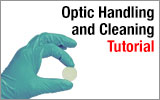
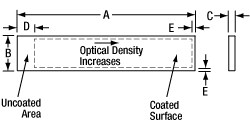
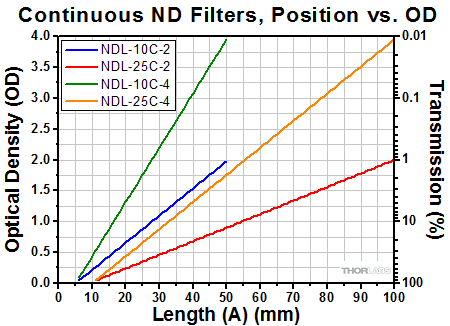
 反射型連続可変NDフィルタ
反射型連続可変NDフィルタ